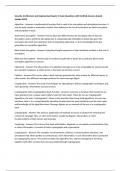Security Architecture and Engineering Chapter 4 Exam Questions with Verified Answers (Latest
Update 2024)
Algorithm - Answers A mathematical function that is used in the encryption and decryption processes. It
may be quite simple or extremely complex. Also defined as the set of instructions by which encryption
and decryption is done.
Asymmetric Encryption - Answers Process that uses different keys for encryption than it does for
decryption, and in which the decryption key is computationally infeasible to determine given the
encryption key itself, from plaintext and corresponding ciphertext, or from knowledge of the key
generation or encryption algorithm.
Block Mode Encryption - Answers Using fixed-length sequences of input plaintext symbols as the unit of
encryption.
Block Size (Encryption) - Answers Size in symbols (usually bits or bytes) for a particular block mode
encryption algorithm or process.
Ciphertext - Answers The altered form of a plaintext message so as to be unreadable for anyone except
the intended recipients. In other words, it has been turned into a secret.
Collision - Answers This occurs when a hash function generates the same output for different inputs. In
other words, two different messages produce the same message digest.
Cryptanalysis - Answers The study of techniques for attempting to defeat cryptographic techniques and,
more generally, information security services.
Cryptographic Hash, Cryptographic Hash Function - Answers A process or function that transforms an
input plaintext into a unique value called a hash (or hash value). These do not use cryptographic
algorithms; the term "cryptographic" refers to the assertion that strong hash algorithms are one-way
functions, that is, it is computationally infeasible to determine the input plaintext from the hash value
and knowledge of the algorithm alone. Message digests are an example of the use of a cryptographic
hash.
Cryptography - Answers The study or applications of methods to secure or protect the meaning and
content of messages, files, or other information, usually by disguise, obscuration, or other
transformations of that content and meaning.
Cryptology - Answers The science that deals with hidden, disguised, or encrypted communications, files,
or other information. It consists of both cryptography and cryptanalysis.
Cryptosystem - Answers The complete set of hardware, software, communications elements, and
procedures that allows parties to communicate, store information, or use information that is protected
by cryptographic means. The system includes the algorithm, key, and key management functions,
together with other services that can be provided through cryptography.
, Cryptovariable(s) - Answers One or more parameters that are inherent to a particular cryptographic
algorithm and its implementation in a cryptosystem. Block size, key length, and number of iterations (or
rounds) are examples of cryptovariables.
Decoding - Answers The reverse process from encoding, converting the encoded message back into its
plaintext format.
Decryption - Answers The reverse process from encryption. It is the process of converting a ciphertext
message back into plaintext through the use of the cryptographic algorithm and the appropriate key for
decryption (which is the same for symmetric encryption, but different for asymmetric encryption). This
term is also used interchangeably with "deciphering."
Encoding - Answers The action of changing a message or other set of information into another format
through the use of a code. Unlike encryption, which obscures or hides the meaning, encoded
information can still be read by anyone with knowledge of the encoding process.
Encryption - Answers The process and act of converting the message from its plaintext to ciphertext.
Sometimes it is also referred to as enciphering. The two terms are sometimes used interchangeably in
literature and have similar meanings.
Encryption System - Answers The total set of algorithms, processes, hardware, software, and procedures
that taken together provide an encryption and decryption capability.
Frequency Analysis - Answers A form of cryptanalysis that uses the frequency of occurrence of letters,
words, or symbols in the plaintext alphabet as a way of reducing the search space.
Hybrid Encryption System - Answers A system that uses both symmetric and asymmetric encryption
processes.
In-Band - Answers Refers to transmitting or sharing control information, such as encryption keys and
cryptovariables, over the same communications path, channel or system controlled or protected by that
information.
Key - Answers The input that controls the operation of the cryptographic algorithm. It determines the
behavior of the algorithm and permits the reliable encryption and decryption of the message. .
Key Escrow - Answers A process by which keys (asymmetric or symmetric) are placed in a trusted
storage agent's custody, for later retrieval. The trustworthiness of the encryption system(s) being used is
thus completely placed in the escrow agent's control.
Key Generation - Answers The process of creating a new encryption (or decryption) key.
Key Management - Answers All processes used to create, store, distribute, and provide expiration and
revocation of encryption and decryption keys, for all users of a particular encryption system.





